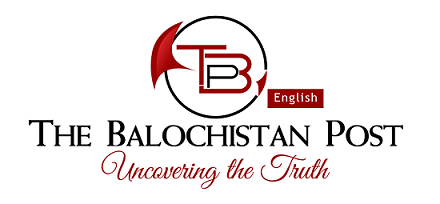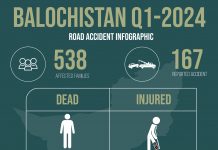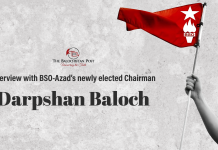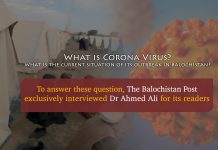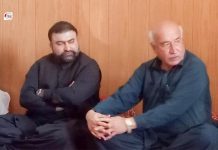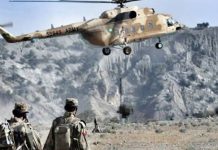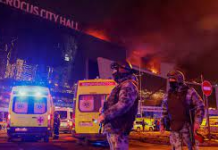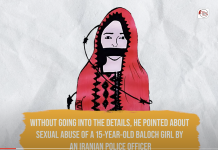By: Ganjal Baloch
Throughout the history of the world, from ancient times to the present day, numerous social acts, political movements, and upheavals, including Pakistan’s occupation of Baloch’s land, have been driven by violence. It appears that violence is an inherent aspect of human nature, and as nature itself is considered unchangeable, it has remained a constant factor in shaping human societies.
From minor social changes to major revolutionary movements, violence has been, is, and likely will continue to be utilized. Although some individuals endorse violence while others vehemently oppose it, the undeniable truth is that violence has been a recurring element in human affairs.
Even those who strongly oppose violence and champion ideals like liberalism and humanism have, at some point, achieved their current positions through violent means. One prominent example of this irony is colonial forces of Europe.
Violence is not something to be celebrated or applauded; that is clear. However, when it comes to human survival, we must acknowledge that reality can sometimes force individuals or groups to resort to violence. In the case of Baloch’s struggle against Pakistan, the choice to employ violence is driven by our quest for survival and freedom.
To truly understand the context and nature of the violence between Baloch and Pakistan, it’s crucial to recognize that Baloch’s resistance or revolutionary acts are often based on violence. This has sparked debates among both Baloch and non-Baloch individuals.
In essence, these debates do not solely revolve around the issue of violence but rather focus on the Baloch resistance movement. These individuals consciously shape their language and wordings to give the appearance of opposition solely to violence, while in reality, their stance is directed against the Baloch resistance movement rather than violence itself.
On one side, there are non-Baloch intellectuals, politicians, and state-sponsored actors who directly oppose the Baloch resistance movement and condemn violence. On the other side, there are our people who, though not directly opposing violence, indirectly oppose the resistance movement. Unfortunately, both groups lack a comprehensive understanding of war and its methods, which makes it important to educate them on how and why this violence began in the first place.
Basically, the act of violence perpetrated by the state of Pakistan on March 27, 1948, forcefully occupied Balochistan. It marked a significant turning point, drawing the first line of “violence” upon the sacred land of the Baloch people.
This violence not only shattered the Baloch people’s sense of autonomy and freedom but also initiated a long-standing struggle for their sovereignty, identity, and self-determination. The subsequent resistance and revolutionary acts carried out by the Baloch are traced back to this pivotal moment of violence that disrupted their way of life and imposed an external rule upon them.
Baloch’s use of violence can be understood as a defensive response to Pakistan’s initial oppressive violence of forcefully occupying their land in 1948. When force is applied against a people, resistance is a natural human phenomenon, and in the case of the Balochs, their resort to violence is driven by their struggle for liberation and protection of their rights and territory.
For over 70 years, Pakistan has utilized various violent methods to suppress Baloch’s identity, suppress our culture and language, and exploit our natural resources. Faced with oppression, barbarism, and genocide, the Baloch people were left with two options: to remain silent and accept the erasure of their identity or to reclaim their freedom. In pursuing their national liberation, like many revolutionary movements, Baloch chose the path of resistance, which involved the use of violence.
It is essential to understand the perspective behind Baloch’s violence, which is primarily defensive in nature. Our actions aim to protect our land and people from further oppression and subjugation. On the contrary, Pakistan’s violence is characterized by its oppressive nature, intending to silence, violate, and subdue the Baloch.
Instead of urging Baloch to stop the intense layer of violence, the focus should be on addressing Pakistan and urging them to surrender, stop the violence, and withdraw their presence from Balochistan. By taking such action, this layer of violence may come to an end. It’s crucial to acknowledge that the violence was initiated by Pakistan, not by Baloch. The Baloch people were left with no other choice but to resort to violence as a response to the negation of their national identity. The solution to stopping this violence lies primarily in Pakistan’s hands. They must cease the war in Balochistan and withdraw their forces.
Those who oppose Baloch’s violence, whether from within or outside, should take the time to study world history and warfare strategies more thoroughly, as their understanding appears to be lacking. The historical context clarifies that Pakistan initiated this violence, and Baloch simply can’t quit it.
Some individuals criticize the levels and statistics of violence, including the new tactic of self-sacrificing (Jind Nadri/Fidayee) attacks. However, this criticism seems baseless and irrational since violence, regardless of its form, is still violence. Violence begets violence, and it cannot be categorized as short or big; it remains an act of violence.
Whether pulling the trigger of a gun with a single bullet or orchestrating an explosion, the reality remains the same: violence is violence. Regardless of the method employed, the outcome is an act of aggression with potentially severe consequences. While violent methods may be cruel, the consequences of defeat can be even worse.
Opposing the Baloch’s violence is futile because rational people initiated this violence, and they are unlikely to halt it; instead, they may intensify it further as they see it as necessary. As a result, the Baloch Liberation Army has heightened its violence strategies, understanding that reducing violence would only invite more aggression from the enemy. The only way to bring an end to this war by Pakistan is through a more substantial show of force.
The natives often resist in the face of oppression, and history shows that this resistance is met with violence. An example is the Baloch struggle for liberation, where many political leaders, workers, and students have been killed and disappeared. In response to this violence, it is arguable that greater violence is necessary to reclaim our land, drawing parallels to the Vietnam War.
During the Vietnam War, millions of Americans took to the streets not necessarily out of sympathy for Vietnam but because the Vietnamese had retaliated with greater violence against America. Today, the Baloch struggle for Liberation acknowledges the need for violence and has intensified its efforts. Bashir Zaib, the commander in chief of the Baloch Liberation Army, stated in one of his video messages that “We have to exert such violence that people across Punjab must come to the streets and demand Pakistan to stop the war.”
Throughout history, it can be observed that no colonized nation has secured liberation without resorting to violence. From examples like Cuba, Vietnam, and Algeria to Bangladesh, violence has been interconnected with the process of decolonization.
In a general sense, violence refers to using force and coercion to cause harm or exert control. However, in the context of post-colonial studies, violence takes on a significant meaning as it pertains to historical and ongoing struggles against colonial domination and oppression. Decolonization, on the other hand, is the process of undoing the effects of colonialism and achieving independence from colonial rule, encompassing the reclaiming of land political, economic, social, and cultural sovereignty for colonized territories and peoples.
Post-colonial studies in the mid-20th century revealed that proponents of violence in decolonization believed that colonial powers maintained control through deeply entrenched oppressive structures. Non-violent resistance often faced brutal suppression, leaving the colonized with limited options to challenge the colonial order. In such circumstances, armed resistance and violence were seen as necessary to break free from the chains of colonial oppression.
Indeed, Fanon focuses on the process of decolonization and the violent struggle for liberation from colonial rule. He contends that violence becomes a crucial tool in the fight for liberation when the oppressed are faced with a system of domination that is fundamentally violent and dehumanizing. As he quotes, “Colonialism is not a thinking machine, nor a body endowed with reasoning faculties. It is violence in its natural state, and it will only yield when confronted with greater violence.”
Fanon does not glorify violence for its own sake but rather emphasizes its instrumental value in breaking the chains of oppression. He argues that colonialism is inherently violent, and thus, violence can be a justified response to dismantle the oppressive system. Fanon refers to this violence as a “decolonizing violence” and sees it as a means for the colonized to reclaim their agency and humanity.
Absolutely, Amílcar Cabral shared similar views on violence as a means of achieving liberation from colonial oppression. His theory on violence echoed the ideas of Frantz Fanon and played a significant role in the fight for independence from Portuguese colonial rule.
Cabral’s writings and speeches emphasized the strategic use of armed struggle and popular mobilization in the context of liberation struggles. He believed that violence, when strategically employed, could serve as a powerful tool to challenge and dismantle the structures of colonial oppression.
Like Fanon, Cabral recognized that colonialism was inherently violent, and the oppressed could not expect to achieve their liberation through peaceful means alone. He saw the armed struggle as a necessary response to the violent and repressive tactics employed by colonial powers. Throughout the struggle for independence in Guinea-Bissau and Cape Verde, Amílcar Cabral’s theories on violence and liberation profoundly impacted the movement. His ideas and leadership contributed significantly to the eventual success of gaining independence from Portuguese colonial rule.
Today, The use of violence by the Baloch Liberation Army (BLA) and other Baloch armed groups can be attributed to their vision for the national liberation of Baloch land. As the BLA’s Commander in chief further states that “We are peace lovers, and we want peace to prevail. But peace comes from the womb of war; therefore, we have chosen violence not by choice, but because we are left with no other choice.” As Ernest Hemingway states in “Men at War” that in a war when the moment arrives, the thing to do is to hit your opponent the first punch and hit him as hard as possible.”
The latest video message from BLA’s chief, Bashir Zaib, rationally discusses why Baloch has resorted to violence. He elaborates on the need to intensify the war to a level where every Punjabi from Punjab would rise and demand Pakistan to stop the war. This conflict is a fight for the dignity, survival, and freedom of the Baloch people, and as a result, the violence will escalate to achieve these goals.
The Baloch struggle for survival and freedom against Pakistan’s violence is deeply rooted in historical oppression, forced occupation, and the negation of their national identity. The Baloch’s use of violence can be seen as a defensive response to Pakistan’s initial oppressive violence, as they we to protect our land, people, and cultural heritage.
While violence is not to be celebrated, the reality of their circumstances has driven the Baloch people to resort to violent means in their pursuit of liberation. The parallels with other successful decolonization struggles show that violence has been intertwined with the process of achieving independence from oppressive colonial rule.
Disclaimer: The views and opinions expressed in this article are those of the author and do not necessarily reflect the official policy or position of The Balochistan Post or any of its editors.
